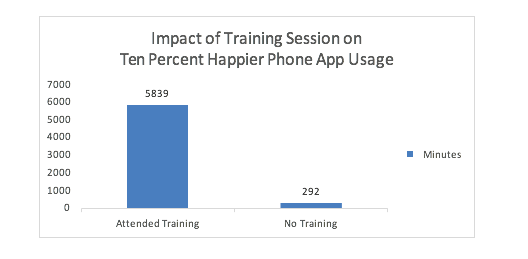Increase Employee Mindfulness App Usage Doing This One Simple Thing

By Deborah Hendricks, EdD, CFLE, Director of Pre-Health Advising & Mindfulness Coach, University of Toledo
Mindfulness Phone Apps
As the popularity of mindfulness meditation has grown in the last few years, so has the number of mindfulness phone apps, such as Ten Percent Happier, Calm, and HeadSpace. Also increasing is the number of businesses incorporating technology into their workplace wellness programs. Last year, I stopped into my local Apple store to purchase a product. While speaking with a store employee, I brought up the subject of mindfulness and mindfulness apps, and she told me that Apple gave all employees the Ten Percent Happier app and encouraged them to participate in a wellness team-challenge with other Apple employees.
Like Apple, more and more businesses are offering mindfulness phone apps as a resource for their employees. With this increase in technological developments comes a demand for scientific research to study the effectiveness of these apps. Unfortunately, to date, little research has been done on the impact mindfulness phone apps have on perceived stress levels as well as the impact that an in-person mindfulness training can have on phone app usage. This is important to examine since, according to a recent survey, only 20% of employees engage in workplace wellness activities (Mattke et al., 2013). Thus, a question to study is how can employers increase the likelihood that employees will use the apps provided to them as a workplace benefit?
Recently, several colleagues and I had the opportunity to study the impact a face-to-face training had on the use of a mindfulness app. In addition, we examined the influence the app had on individuals’ mindfulness and stress levels. Over the course of a year, we studied how the Ten Percent Happier phone app affected the mindfulness and perceived stress levels of academic advisors within a large, Midwest public university setting. We chose the Ten Percent Happier app because it is grounded in evidence-based content and is recommended by doctors (Change Collective, 2017; Rebedew, 2018).
The Study
To initiate the study, we offered academic advisors a choice: (1) participate in a one-time professional development training session which included access to the app or (2) receive access to the app without attending the training. The training session was three hours in length, and advisors were allowed to attend the training as part of their workday. We gathered self-reported data from participants prior to the study (a pre-training questionnaire using the Mindfulness Attention and Awareness Scale from Brown and Ryan, 2003 and the Perceived Stress Scale from Cohen et al., 1983) as well as a year afterward (post-tests—subjects re-took these same instruments). Our study addressed the following questions: Did attending the professional development training session increase the use of the Ten Percent Happier phone app? Was there an association between use of the Ten Percent Happier app and levels of perceived stress and mindfulness?
Results
In our study, 33 out of 47 solicited academic advisors participated and completed all pre- and post-tests. All participants were given full access to the Ten Percent Happier app with no obligation to use the app, nor were they given any specified or suggested time requirements; participants were told to use the app as little or as much as they wanted. As such, a total of 20 out of 33 participating advisors downloaded and used the app; 13 did not use the app.
Prior to downloading the app, participants were invited to attend a three-hour training session. A total of 18 advisors attended this professional development training which I developed to include various discussions, exercises, and application such as:
- Basic definitions related to mindfulness
- A general overview on the history of mindfulness-based stress reduction
- A hands-on practice of focusing on the breath followed by sharing and journaling
- A walking exercise
- A hands-on practice of scanning the body followed by reflection
- Recent research on mindfulness
- A loving-kindness exercise
- A dyad/pair listening exercise
- A demonstration of how to incorporate mindfulness exercises with students followed by a role-play
- Journaling
- A gratitude practice
- Whole-group discussion/reflection on what advisors learned/practiced
- Q & A
After one year, we found participants who downloaded the app and attended the training accessed the app 652 times, totaling 5,839 minutes compared to those who did not attend the training; they accessed the app 48 times, totaling 292 minutes. Overall, 20 out of 33 (61%) participants in our study used the app for a total of 700 times for 6,131 minutes.
Impact of Training Session on Ten Percent Happier Phone App Usage

At the end of the year-long study, we found statistically significant results with increased levels of mindfulness and decreased perceived stress among participants who used the app. 85% of advisors agreed or strongly agreed that practicing mindfulness was beneficial to their self-care and well-being.
What This Means for the Workplace
While this study examined the effect of a one-time training on app usage and the effectiveness of the mindfulness phone app among academic advisors, the results can certainly be extrapolated to others in the workplace, especially as more and more employers are encouraging their employees to engage in various self-care activities. Our findings suggest that an initial education training session about mindfulness can increase usage of a phone app. Employers wishing to offer a mindfulness app to their employees could first offer an educational professional development session to explain ways to practice and the possible benefits. Offering this initial mindfulness training and then relying on a mindfulness app as a resource for ongoing support could be a feasible and effective component of employee wellness programs.
For employees, establishing a regular meditation discipline is important for increasing the ability to focus and decreasing stress. A growing body of research—including our study—shows that a regular mindfulness practice results in positive outcomes such as lowered stress, heightened awareness, increased focus as well as other physical and emotional benefits (Baer, 2003; Brown et al., 2015). Receiving a tool like a mindfulness phone app as well as instruction about how to use it could help employees establish or continue a regular practice of mindfulness, thus positively impacting their work environments.
As a result of our year-long study, we believe that a brief pre-training session could make the use of meditation phone apps more effective for users. For example, companies like Apple could make their offer of the Ten Percent Happier phone app even more beneficial to their employees by offering a short training session beforehand. This could be a face-to-face session or a recorded audio/video demonstration. Encouraging their employees to use a mindfulness phone app could, in turn, result in more contented and unstressed employees.
Today, there are more and more options and platforms for mindfulness training programs that companies can provide for their employees—from online formats to structured face-to-face sessions or one-time training events—to aid in the regular use of a meditation smartphone app. As more people are exploring the practice of mindfulness and using apps as a resource, our study supports the growing body of research that helps bring light to the effectiveness of technology in this area.
Change Collective. (2017). Change Collective. Inc. (Version 4.6.0) [Mobile application software]. Retrieved June 20, 2017 from http://itunes.apple.com.
Cohen, S., Kamarck, T., & Mermelstein, R. (1983). A global measure of perceived stress. Journal of Health and Social Behavior, 24(4), 385–396.
Hendricks, D. S., Lavery, M. R., Bouillon, L. E., & Gotfried, R. S. (2019). Evaluating the Effectiveness of a Mindfulness App Among Academic Advisors. Journal of Technology in Behavioral Science, 1-7.
Mattke, S., Schnyer, C., & Van Busum, K. R. (2013). A review of the US workplace wellness market. Rand Health Quarterly, 2(4).
Rebedew, D. (2018). Five mobile apps for mindfulness. Family Practice Management, 25(3), 21–24.
Dr. Hendricks serves as the Director and Mindfulness Coach of The Pre-Health Advising Center at The University of Toledo. Deborah developed and teaches mindfulness workshops for college students and faculty. In addition, she serves as a guest speaker and educator in university classrooms, community workshops, organizations and presents both regionally and nationally at professional conferences on mindfulness. Deborah is a Certified Family Life Educator and holds a Bachelor of Science in Human Development and Family Studies, a Master of Arts in College Student Personnel, and a Doctor of Education in Leadership Studies, all from Bowling Green State University.

1 comment
Software testing is a crucial process in the development of software applications to ensure their quality, reliability, and functionality. It involves executing the software with the intention of finding defects or errors and verifying that it meets the specified requirements. There are various types of software testing techniques and methodologies, including:
Unit Testing: It focuses on testing individual components or units of the software to verify their correctness and functionality.
Integration Testing: It tests the interaction between different components or modules to ensure they work together correctly.
System Testing: It tests the entire system as a whole to validate its compliance with functional and non-functional requirements.
Acceptance Testing: It involves testing the software from the end-user’s perspective to determine if it meets the user’s requirements and business needs.
Performance Testing: It assesses the software’s performance under various conditions, such as load testing (testing its response under heavy user loads) or stress testing (testing its stability under extreme conditions).
Security Testing: It focuses on identifying vulnerabilities and weaknesses in the software to ensure it can withstand malicious attacks.
Usability Testing: It evaluates the software’s user-friendliness and ease of use by involving end-users in testing activities.
Regression Testing: It retests modified or updated parts of the software to ensure that changes have not introduced new defects or negatively impacted existing functionality.
Exploratory Testing: It involves simultaneous learning, designing, and executing test cases to discover defects in an ad-hoc manner.
Software Testing Course in Pune
Software Testing Classes in Pune
Leave a comment